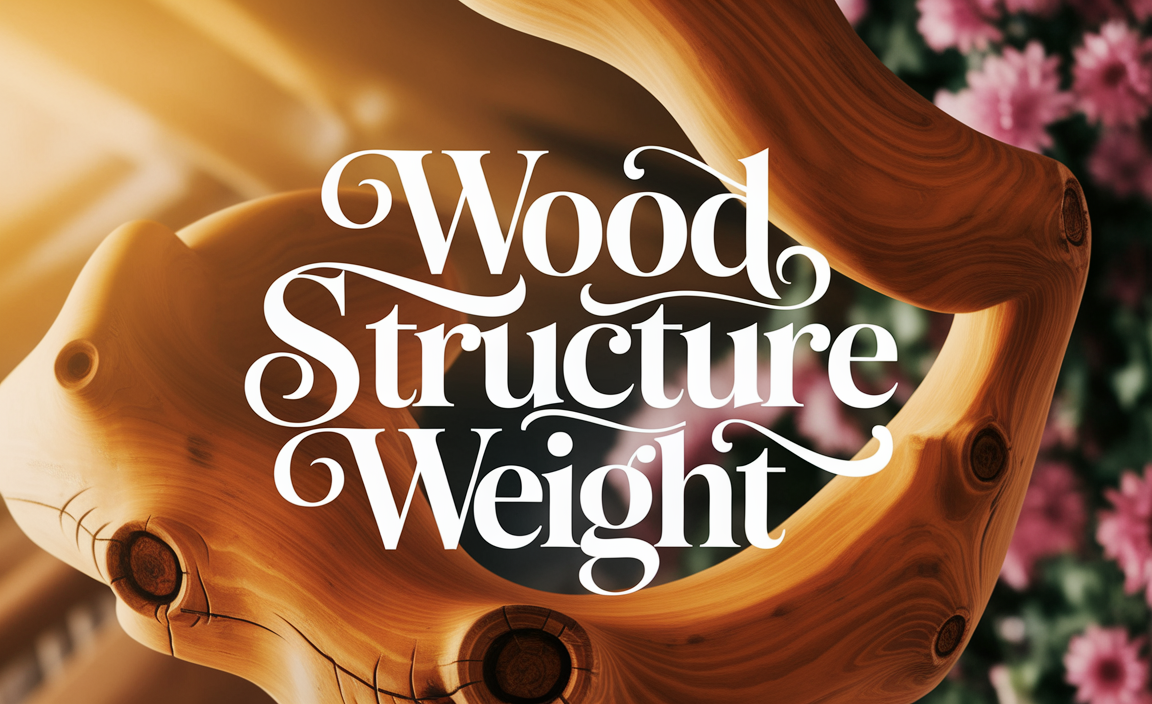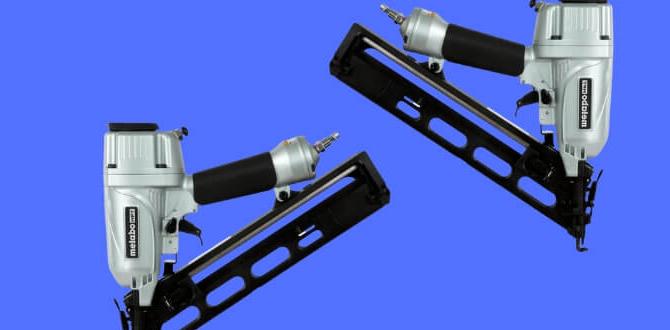Quick Summary:
Learn how to build a beautiful wooden mailbox with a planter top! This step-by-step guide uses simple tools and clear instructions, perfect for beginner woodworkers. Enhance your curb appeal with this functional and charming DIY project.
Hey there, DIY enthusiasts! Jack Shaffer here from Nailerguy. Ever look at your average mailbox and think, “There has to be a more charming way?” I know I have! A standard mailbox can be a bit… well, plain. But what if you could add a touch of green, a burst of color, and a whole lot of personality right where your mail lands? Building a wooden mailbox with a planter top is a fantastic way to do just that. It’s a project that combines practical postal needs with the beauty of gardening, and trust me, even if you’re just starting out with woodworking, you can totally nail this. We’ll walk through it step-by-step, making it easy and fun. Ready to give your home’s entrance a real upgrade?
Table of Contents
Why Build a Wooden Mailbox with Planter Top?
A standard mailbox is functional, no doubt. But it’s often just a metal or plastic box that gets the job done. A wooden mailbox with a planter top, however, transforms this everyday item into a decorative feature for your home. It adds warmth and natural beauty, instantly boosting your curb appeal.
Think about it: a sturdy wooden structure housing your mail, topped with vibrant flowers or greenery. It’s welcoming, it’s unique, and it’s a project you can be proud of. Plus, it’s a great way to get a small garden started, even if you don’t have a lot of yard space. This guide is designed to be straightforward, so you’ll have all the confidence you need to tackle this rewarding project.
What You’ll Need: Gathering Your Supplies
Before we dive into building, let’s make sure you have everything you need. Having your tools and materials ready makes the building process much smoother. We’ll focus on using common woodworking tools you might already have or can easily acquire.
Essential Tools:
- Safety Glasses: Always protect your eyes!
- Measuring Tape: For accurate cuts.
- Pencil: To mark your measurements.
- Saw: A circular saw or miter saw is ideal for straight cuts. A handsaw can work too, but it takes more effort.
- Drill/Driver: With various drill bits and screwdriver bits.
- Clamps: To hold pieces together while you work.
- Orbital Sander: Or sandpaper (80-grit and 120-grit) for smoothing.
- Paintbrushes: For applying finishes.
- Level: To ensure everything is straight.
Materials You’ll Need:
The type and quantity of wood will depend on your specific plan, but here’s a general list. Cedar or redwood are excellent choices for outdoor projects because they are naturally resistant to rot and insects. Pine is more budget-friendly but will require good sealing and painting.
- Lumber:
- 1×6 lumber (for main mailbox box)
- 1×8 lumber (for planter box sides and bottom)
- 4×4 posts (for the main support, if not mounting on an existing post)
- Plywood or exterior-grade particle board (for mailbox bottom)
- Optional: 1×4 or 1×6 for decorative trim or a roof overhang.
- Screws: Exterior-grade wood screws (1 ¼-inch and 2-inch are common).
- Wood Glue: Exterior-grade, waterproof wood glue.
- Hardware: Hinges for the mailbox door (if making one), a latch or magnetic catch.
- Finishing Supplies: Exterior primer, exterior paint or stain suitable for outdoor use.
- Planter Liner: Heavy-duty plastic sheeting or a landscape fabric liner to protect the wood from soil moisture.
- Optional: Gravel or pea gravel for drainage in the planter.
Planning Your Mailbox Design
Before you cut any wood, it’s a good idea to sketch out your design. This doesn’t need to be a fancy architectural drawing, just a simple visualization of how the pieces will fit together. Think about the size of the mailbox, the dimensions of the planter, and how it will attach to your post or stand.
Most standard mailboxes are about 6 inches wide, 8 inches high, and 20 inches long. You can adjust these dimensions, but keep in mind USPS regulations for mailbox size and placement. The planter box can be designed to sit directly on top of this main structure. A common approach is to make the planter box slightly wider and longer than the mailbox itself, creating a bit of an overhang.
Consider the depth of your planter. A depth of 6-8 inches is usually sufficient for most flowering plants and shallow-rooted herbs. Make sure your design allows for good drainage from the planter.
Basic Mailbox Dimensions (Example):
These are just suggestions – feel free to adapt!
- Main Box: 6 inches wide, 8 inches high, 20 inches long.
- Planter Box: 8 inches wide, 8 inches high, 22 inches long.
Drainage is Key!
This is super important for the longevity of your planter and the health of your plants. You’ll need to ensure water doesn’t sit in the bottom of the planter. This can be achieved by:
- Drilling several ½-inch holes in the bottom of the planter box.
- Using a layer of gravel at the bottom before adding soil.
- Lining the planter with a material that allows water to escape but keeps soil in.
Locating Your Mailbox
Before you build, check your local postal service’s guidelines for mailbox placement. This usually involves specific distances from the road and desired height. A standard height is about 41 to 45 inches from the ground to the bottom of the mailbox. You can find these guidelines on the USPS website.
Cutting Your Wood Pieces
Now for the fun part – making the cuts! Accuracy here will make assembly much easier. Double-check your measurements before each cut.
Mailbox Box Cuts (using 1×6 lumber):
- Front and Back Panels: Two pieces, each 6 inches wide x 8 inches high.
- Side Panels: Two pieces, each 6 inches wide x 18 inches long (this accounts for the thickness of the front and back panels to achieve a 20-inch length).
- Bottom Panel: One piece of plywood or exterior-grade particle board, 6 inches wide x 18 inches long.
- Roof: One piece, 7 inches wide x 20 inches long (this provides a slight overhang).
- Door (Optional): One piece of 1×6, 6 inches wide x 8 inches high. If you’re making a door, you might rip it slightly narrower to allow for clearance.
Planter Box Cuts (using 1×8 lumber):
- Front and Back Panels: Two pieces, each 8 inches wide x 20 inches long.
- Side Panels: Two pieces, each 8 inches wide x 6 inches long (this accounts for the thickness of the front and back panels for an 8-inch width).
- Bottom Panel: One piece of 1×8 lumber, 8 inches wide x 20 inches long.
Support Post Cuts (if needed, using 4×4):
- Cut one piece to the desired height, ensuring it’s tall enough not to violate USPS height regulations when the mailbox is attached. A typical height might be 4-5 feet.
Assembling the Mailbox Body
Let’s start with the main mail-holding part. This is where your exterior wood glue and screws come in handy.
- Attach Side Panels to Front Panel: Take one of your 6″ x 8″ front/back panels and two of your 6″ x 18″ side panels. Apply exterior wood glue to the edges of the front panel where they will meet the side panels. Position the side panels so they butt up against the edges of the front panel. Use clamps to hold them in place.
- Drill Pilot Holes: To prevent the wood from splitting, drill pilot holes through the side panels into the edge of the front panel. Use a drill bit slightly smaller than your screw diameter.
- Secure with Screws: Drive 1 ¼-inch exterior wood screws through the pilot holes to secure the side panels to the front. Use about 3-4 screws per side.
- Attach the Back Panel: Repeat steps 1-3 to attach the back panel to the other ends of the side panels. You should now have a U-shaped box.
- Add the Bottom: Apply glue to the bottom edges of the assembled box. Place the 6″ x 18″ plywood/particle board bottom panel and align it flush with the outer edges. Drill pilot holes from the bottom up into the side, front, and back panels. Secure with 1 ¼-inch screws.
Adding the Roof:
Center the 7″ x 20″ roof piece on top of the assembled box, allowing for a slight overhang on the front, back, and sides. Apply glue to the top edges of the box. Drill pilot holes down through the roof into the side, front, and back panels. Secure with 1 ¼-inch screws. For extra durability, you can add screws along the front and back edges.
Adding a Door (Optional):
If you’re adding a door, you’ll need to attach it to the front panel. You can use small exterior hinges. Position the door so it swings open smoothly. Small hinges usually only require 2-3 screws per leaf. Add a simple magnetic catch or a small wooden knob to make it easy to open and close. Hinges are readily available at hardware stores.
Constructing the Planter Box
This part is very similar to building the main mailbox body, but it will be slightly larger and open at the top.
- Attach Sides to Front/Back: Take your two 8″ x 20″ front/back panels and two 8″ x 6″ side panels. Apply exterior wood glue to the edges where they will join. Assemble them into a rectangular box shape (8″ high x 20″ long x 8″ wide when outer pieces are attached). Use clamps to hold the pieces firmly.
- Drill Pilot Holes and Screw: Drill pilot holes through the side panels into the edges of the front and back panels. Secure with 1 ¼-inch exterior wood screws.
- Attach the Bottom: Apply glue to the bottom edges of the planter box frame. Place the 8″ x 20″ bottom panel flush with the outer edges. Drill pilot holes from the bottom up into the walls. Secure with 1 ¼-inch screws.
- Drill Drainage Holes: This is crucial! Using a ½-inch drill bit, drill at least 4-6 holes through the bottom panel of the planter box. You can add more for better drainage.
Lining the Planter:
To protect the wood from constant moisture and soil, line the inside of the planter box. You can use heavy-duty plastic sheeting (like pond liner material) or a thick landscape fabric. Cut the liner to fit the inside of the planter, stapling it securely around the top edge. Make sure to cut small holes in the liner where you drilled drainage holes in the wood bottom so water can escape.
Joining the Mailbox and Planter
Now it’s time to bring your two main components together. The planter box will sit directly on top of the mailbox body. Ensure your planter box is centered on the mailbox roof, with a nice overhang on all sides.
- Position the Planter: Carefully place the assembled planter box on top of the mailbox roof. Adjust until it’s centered.
- Secure from Below: The easiest and cleanest way to join them is to drive screws from the inside of the mailbox body up into the bottom of the planter box. Reach inside the main mailbox, drill pilot holes up through the mailbox roof panel into the planter’s bottom panel, and then drive 1 ¼-inch screws. Use at least 4 screws, one near each corner, for a strong connection.
Finishing Your Wooden Mailbox
This is where your project really comes to life and gets the protection it needs to last outdoors. Proper finishing is key for longevity, especially if you didn’t use rot-resistant wood like cedar or redwood.
Sanding:
- Start with 80-grit sandpaper to smooth out any rough edges, saw marks, or imperfections.
- Follow up with 120-grit sandpaper for a finer finish.
- Wipe away all dust with a tack cloth or damp rag.
Priming and Painting (or Staining):
- Prime: Apply at least two coats of a good quality exterior primer. This helps the paint adhere better and provides an extra layer of protection against moisture and UV rays. Let each coat dry completely according to the manufacturer’s instructions.
- Paint/Stain: Apply 2-3 coats of your chosen exterior paint or stain. Light colors are generally better for outdoor furniture and structures as they reflect heat, but choose what you love! Make sure to cover all surfaces, including the underside of the roof and the inside edges of the planter.
- Allow to Cure: Let the finish cure completely for a few days before exposing it to heavy weather or planting.
Alternative Finishes:
- Water-based Sealant: For a more natural look, you can use an exterior-grade water-based sealant or a clear coat. This will protect the wood but allow its natural grain to show through.
- Oil-Based Finish: Some exterior oil-based stains and sealers can also provide excellent protection and enhance the wood’s appearance.
Always check the product’s specifications to ensure it’s suitable for outdoor use and the type of wood you’ve selected. For more information on wood finishing, resources like Woodworking Network offer great insights.
Mounting Your New Mailbox
This is the final step! Your mailbox needs a sturdy home. You can mount it on an existing post, a new wooden post, or even a metal pole.
Mounting on a Post:
If you’re installing a new 4×4 post:
- Dig the Hole: Dig a hole for your post that is about 2-3 feet deep. The exact depth will depend on your local climate and soil type (deeper is better in frost-prone areas).
- Set the Post: Place the 4×4 post in the hole. Use a level to ensure it is perfectly plumb (straight vertically) in both directions.
- Secure the Post: Mix concrete according to the instructions on the bag and pour it into the hole around the post. You can also


